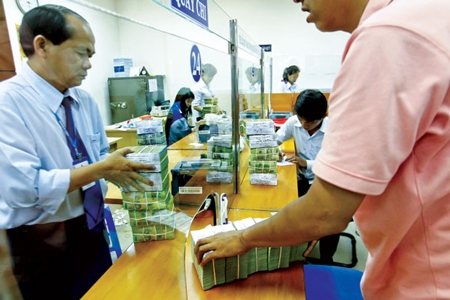>> Lower rates fail to spur economy
>> State bank continues tightening ceiling interest rates
>> State bank takes drastic measures to lower interest rates
With banks required to comply with a ceiling deposit interest rate of 14% per year since September, capital accumulation and the offering of credit in the banking system have decreased along with a rise in foreign exchange rates.

Saving rates of 14% are proving highly unattractive to depositors
Fewer deposits and gloomy lending have triggered worries about low liquidity and driven up inter-bank interest rates.
While the VND/USD rate is falling in the unofficial market, the situation is the reverse on the inter-bank market.
Low liquidity
Truong Van Phuoc, General Director of Eximbank, said bank deposits had decreased by 2% over the past month. The same decrease was recorded in institutional lending.
From July to September, savings at Eximbank were down nearly VND4 trillion (USD191.43 million), with the bank sometimes recording withdrawals of up to VND400-500 billion (USD19.14 million-USD23.92 million) in a day.
Leaders of several other banks admitted they faced the same situation, matching SBV forecasts on banking operations for the third quarter of this year.
In early September, the SBV took drastic measures to request banks to comply with the deposit interest rate cap of 14% per year, a move that has discouraged deposits.
Due to the unattractive savings rate, many people withdrew their money from banks to buy gold amid a fall in gold prices in the middle of September. Many others switched to buy US dollars instead of depositing their money. These trends have resulted in lower capital reserves.
Phuoc attributed the decreased outstanding loans over the past month to business operations. Many companies faced difficulties, and had to curb production, suspend operations or file for bankruptcy.
Despite loan rates decreasing, many firms continue to find it difficult to afford to take bank loans, he added.
Decreased savings have led to concern among financial institutions about low liquidity, which has driven up inter-bank interest rates. From October 3-11, inter-bank interest rates increased to between 14.5%-15% for overnight terms, between 15%-15.5% for one-week terms, between 15.5%-16% for two-week terms, and between 16-17.5% for one-month terms.
In late September, inter-bank interest rates ranged from only 12.7% to 13.93%.
Early hike in foreign exchange rates
Foreign exchange rates have increased sooner than expected due to the impact of the gold market.
By October 13, the inter-bank rate had consistently increased to VND20,678/USD. Many commercial banks have raised the price of US dollars, to between VND20,880 and VND20,885/USD at Vietcombank, and to VND20,878-VND20,883/USD at Eximbank and ACB.
Banks have tended to drive up the price of the US dollar in a bid to narrow the disparity between the buying and selling prices. Dollar transactions in the inter-bank market have also increased.
Typically in Vietnam US dollar demand increases in remaining months of the year due to a higher trade deficit.
Le Xuan Nghia, Vice Chairman of the National Financial Supervisory Committee, said the disparity between the country’s USD lending and USD deposits reached USD7.5 billion, driving up the inter-bank foreign exchange rate.
The early rise in foreign currency demand was also the result of a soaring rise in recent gold imports. In previous years, gold traders boosted exports from the third quarter but the situation was the reverse this year.
In addition to the importation of five tonnes of gold in the first eight months of this year, banks and gold firms had to buy an additional 10 tonnes of gold over the past week in order to boost domestic supply.
Adding to the complexity is the fact that two different foreign exchange rates are being applied parallel. A leader of a firm specialising in importing agricultural and irrigation machines said they had a bank loan worth USD50,000 that would fall due by the end of this month. They were compelled to buy US dollars from the bank to pay off their debt at a higher rate of VND21,450/USD versus the bank’s listed rate of VND20,885/USD.

Leave your comment on this story